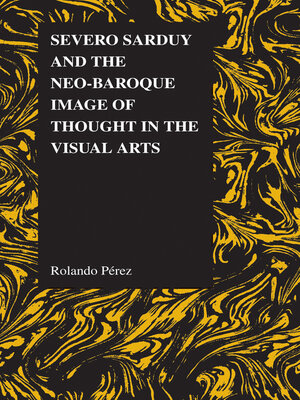Severo Sarduy and the Neo-Baroque Image of Thought in the Visual Arts
ebook ∣ Purdue Studies in Romance Literatures
By Rolando Pérez

Sign up to save your library
With an OverDrive account, you can save your favorite libraries for at-a-glance information about availability. Find out more about OverDrive accounts.
Find this title in Libby, the library reading app by OverDrive.



Search for a digital library with this title
Title found at these libraries:
| Library Name | Distance |
|---|---|
| Loading... |
Severo Sarduy never enjoyed the same level of notoriety as did other Latin American writers like García Márquez and Vargas-Llosa, and his compatriot, Cabrera-Infante. On the other hand, he never lacked for excellent critical interpretations of his work from critics like Roberto González Echevarría, René Prieto, Gustavo Guerrero, and other reputable scholars. Missing, however, from what is otherwise an impressive body of critical commentary, is a study of the importance of painting and architecture, firstly, to his theory, and secondly, to his creative work. In order to fill this lacuna in Sarduy studies, Rolando Pérez's book undertakes a critical approach to Sarduy's essays—Barroco, Escrito sobre un cuerpo, "Barroco y neobarroco," and La simulación—from the stand point of art history. Often overlooked in Sarduy studies is the fact that the twenty-three-year-old Sarduy left Cuba for Paris in 1961 to study not literature but art history, earning the equivalent of a Master's Degree from the École du Louvre with a thesis on Roman art. And yet it was the art of the Italian Renaissance (e.g., the paintings as well as the brilliant and numerous treatises on linear perspective produced from the 15th to the 16th century) and what Sarduy called the Italian, Spanish, and colonial Baroque or "neo-baroque" visually based aesthetic that interested him and to which he dedicated so many pages. In short, no book on Sarduy until now has traced the multifaceted art historical background that informed the work of this challenging and exciting writer. And though Severo Sarduy and the Neo-Baroque Image of Thought in the Visual Arts is far from being an introduction, it will be a book that many a critic of Sarduy and the Latin American "baroque" will consult in years to come.







